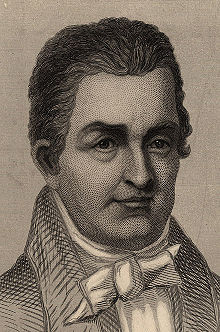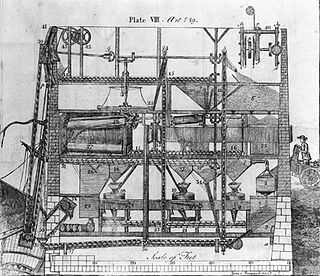This Week in History
January 29-February 4, 1787:
Oliver Evans Brings the New Nation
Into the Machine Age
January 2012
 Oliver Evans. Engraving by W.D. Jackman, cropped. |
A patent from the new state of Delaware was granted on January 30, 1787, to 32-year-old Oliver Evans, a former wheelwright with a deep interest in scientific experimentation. The patent was for elements of what would become a completely automated flour mill, presaging the automated production processes of modern factories. Because the Federal patent system did not yet exist, Evans also patented his designs with the states of Maryland and New Hampshire, where his application also included a description of "a steam-carriage, so constructed as to move by the power of steam and the pressure of the atmosphere, for the purpose of conveying burdens without the aid of animal force."
As Evans improved his automation process, he realized that the technical books he had eagerly devoured were inadequate and, in some cases, just plain wrong. He determined to write a technical handbook for the young mechanics of the nation, and painstakingly conducted experiments so that his introductory Principles of Mechanics and Hydraulics would correspond to what actually happened in practice. Despite the many people, including George Washington and Thomas Jefferson, who took out subscriptions to help fund the work, Evans had to borrow $1,000 from John Nicholson, the Comptroller General of Pennsylvania, to have the expensive illustrative plates printed. The Young Mill-Wright and Miller's Guide, published in 1795, went into 15 editions, was translated into French, and was not superceded until the time of the Civil War.
In 1801, Evans set out to build a steam carriage. His work led him to believe that the nation was in more immediate need of, and probably more receptive to, steam power for manufacturing. When he proposed to the Lancaster Turnpike Company that they commission him to build a large steam wagon to carry flour on the new road, from the agricultural interior of Pennsylvania, to Philadelphia, he was turned down. He resolved to lay aside the carriage project "for a time of more leisure," and concentrated instead, on developing a high-pressure steam engine which could out-perform the low-pressure engines of Newcomen and Watt. Evans eliminated the condenser, so his engine was much smaller than a low-pressure engine of equal power, and consequently, much easier to build and transport to its workplace.
|
Automated flour mill. Illustration by James Poupard from "The young mill-wright & miller's guide: in five parts, embellished with twenty five plates" by Oliver Evans, of Philadelphia. Printed for, and sold by the author, 1795. |
By February 1803, Evans's first engine was at work in his Philadelphia store, powering a screw mill which pulverized plaster of Paris. He also set it up to saw marble, which he knew would attract the attention of his customers, who would then learn more about the advantages of steam engines. Evans wrote that "the driving of twelve saws in heavy frames, sawing at the rate of a hundred feet of marble in twelve hours, made a great show, and excited much attention." Visitors asked him if the engine might power a sawmill for wood, or if it could grind grain, or power a steamboat. Although he always answered, "Yes," he wrote that he "found they still doubted."
But Evans kept returning to the idea of a self-propelled vehicle. Finally, in the summer of 1805, the Philadelphia Board of Health commissioned him to build a dredger which could clean docks and rid the Schuylkill River of sandbars and other obstacles. Evans designed a steam dredger on wheels which became a boat in the water. It was 30 feet long, 12 feet broad, and weighed 17 tons. He drove it through the streets of Philadelphia, exhibited it to the populace, and then floated it in the river, where it successfully completed its mission.
During the years 1806-1812, Evans built and organized the Mars Works, a full-scale complex of engineering shops, in which he constructed his engines, boilers, and heavy machinery. The works included a pattern shop, iron foundry, blacksmith shop, and a steam-engine manufactory, and then Evans added a line of iron gears used to drive machinery. By 1811, the Mars Works employed 35 mechanics, and, during the War of 1812, it produced cast-iron cannon for the U.S. Navy.
Because of the needs of the rapidly-growing Ohio Valley, Evans also organized the Pittsburgh Steam Engine Company, which not only manufactured high-pressure steam engines, but added a brass foundry and produced anvils and even anchors for Ohio River ships. By 1814, Evans had manufactured steam engines that were grinding grain, sawing lumber, drawing wire, rolling and slitting iron, grinding lead, spinning cotton, manufacturing cloth, and powering boats. In the process of perfecting his manufacturing techniques, Evans also developed designs for artificial refrigeration, steam radiators, gas lighting, self-oiling shaft bearings, and a long list of other improvements which would be brought to fruition by others.
Because of the difficulties he had faced in bringing his inventions to the operating stage, Evans argued that the Federal government should sponsor research and development. He wrote that "if government would, at the expense of the community, employ ingenious persons, in every art and science, to make with care every experiment that might possibly lead to the extension of our knowledge of principles, carefully recording the experiments and results so that they might be fully relied on, and leaving readers to draw their own inferences, the money would be well-expended; for it would tend greatly to aid the progress of improvement in the arts and sciences."
Evans also thought that private means should be used to carry out specific research and development. He tried, in 1805, to organize a private research association called "The Experiment Company." Its immediate purpose was to raise $3,000 to develop the steam wagon for transporting goods, the invention so dear to his heart.
Evans wrote a prediction for the Americans of his time, and for ours, stating that "men now living" would see the Western waters covered with steamboats, and that a child already born would travel from Philadelphia to Boston in a single day. "The time will come, when people will travel in stages moved by steam engines, from one city to another, almost as fast as birds fly, fifteen or twenty miles an hour," and those stages would move on rails. "A carriage will set out from Washington in the morning, the passengers will breakfast at Baltimore, dine at Philadelphia, and sup at New York the same day.... And it shall come to pass, that the memory of these sordid and wicked wretches who opposed such improvements, will be execrated, by every good man, as they ought to be now."

